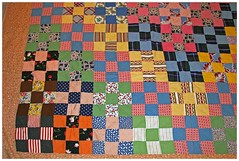 Image by californiaAmy via Flickr
Image by californiaAmy via Flickr
Greetings Quilt Block Maker
You may remember that last time we talked about the grid of
a quilt block, and that some blocks are divided into 4
squares - making them a 4 patch.
Blocks that are divided into 9 little squares are called 9
patch quilt blocks, while a 5 patch is typically divided
into 25 patches - 5 across and 5 down.
Not to confuse the issue too much, but the 4 patch quilt
block and 9 patch quilt block categories have sub categories.
When you look at the sub categories, they make sense, and
as you become more familiar with blocks and begin to put
them into their proper category, it helps to understand
the sub categories.
Four Patch Categories:
There are three sub categories of the four patch quilt block.
The simplest 4 patch is a block divided into 4 squares. One
subcategory has 4 squares (patches) on each side, making a
total of 16 patches in the block.
The other sub category has 8 patches across and 8 patches
down, making 64 patches in the block.
The fun part is that completely different designs can be
made just by changing the subdivisions within each of the
patches in the block.
Nine Patch Categories:
There are 2 basic categories of 9 patch quilt blocks. One
is simply a block with 9 squares in it.
The other is a block that has 6 patches across and 6 patches
down, making a total of 36 patches in the block.
Five Patch and Seven Patch Blocks:
The 5 patch and 7 patch quilt blocks seem to be limited to
being sub-divided into twice as many patches as they started
with.
That means that a 5 patch would have 10 patches across and up
and down; and a 7 patch would have 14 patches across and up
and down. Simple!
With that knowledge as a beginning, drafting a quilt block
pattern is easier. All you need to do is connect the various
grid lines with straight or diagonal lines, which we will
start to cover in the next edition.
The ability to recognize the categories that patterns fall
into makes it easier to find a particular pattern, since
many books of quilt blocks have the patterns grouped by
categories.
QuiltBlockLibrary.com makes finding a pattern somewhat
easier. We have created many categories in addition to
the number of patches. Some of our categories include:
Traditional, Things Found on a Farm, Animals, Baskets,
Boats, Countries, Cities - - and the list could go on.
It's all set up to make it easy for you to find a block
and get your creativity pumping as you search the site.
We understand that often it is easier to understand things
when you actually see them.
So, we have created a couple of pictures of the different
4 patch , 5 patch, 7 patch and 9 patch categories:
http://www.quiltblocklibrary.com/blocks.html
Playful Piecing!
Penny Halgren
www.QuiltBlockLibrary.com
www.TheQuiltingCoach.com
Hobbs Holdings Unlimited, Inc., 7925 pasadena ave, la mesa, CA 91941, USA
You may remember that last time we talked about the grid of
a quilt block, and that some blocks are divided into 4
squares - making them a 4 patch.
Blocks that are divided into 9 little squares are called 9
patch quilt blocks, while a 5 patch is typically divided
into 25 patches - 5 across and 5 down.
Not to confuse the issue too much, but the 4 patch quilt
block and 9 patch quilt block categories have sub categories.
When you look at the sub categories, they make sense, and
as you become more familiar with blocks and begin to put
them into their proper category, it helps to understand
the sub categories.
Four Patch Categories:
There are three sub categories of the four patch quilt block.
The simplest 4 patch is a block divided into 4 squares. One
subcategory has 4 squares (patches) on each side, making a
total of 16 patches in the block.
The other sub category has 8 patches across and 8 patches
down, making 64 patches in the block.
The fun part is that completely different designs can be
made just by changing the subdivisions within each of the
patches in the block.
Nine Patch Categories:
There are 2 basic categories of 9 patch quilt blocks. One
is simply a block with 9 squares in it.
The other is a block that has 6 patches across and 6 patches
down, making a total of 36 patches in the block.
Five Patch and Seven Patch Blocks:
The 5 patch and 7 patch quilt blocks seem to be limited to
being sub-divided into twice as many patches as they started
with.
That means that a 5 patch would have 10 patches across and up
and down; and a 7 patch would have 14 patches across and up
and down. Simple!
With that knowledge as a beginning, drafting a quilt block
pattern is easier. All you need to do is connect the various
grid lines with straight or diagonal lines, which we will
start to cover in the next edition.
The ability to recognize the categories that patterns fall
into makes it easier to find a particular pattern, since
many books of quilt blocks have the patterns grouped by
categories.
QuiltBlockLibrary.com makes finding a pattern somewhat
easier. We have created many categories in addition to
the number of patches. Some of our categories include:
Traditional, Things Found on a Farm, Animals, Baskets,
Boats, Countries, Cities - - and the list could go on.
It's all set up to make it easy for you to find a block
and get your creativity pumping as you search the site.
We understand that often it is easier to understand things
when you actually see them.
So, we have created a couple of pictures of the different
4 patch , 5 patch, 7 patch and 9 patch categories:
http://www.quiltblocklibrary.com/blocks.html
Playful Piecing!
Penny Halgren
www.QuiltBlockLibrary.com
www.TheQuiltingCoach.com
Hobbs Holdings Unlimited, Inc., 7925 pasadena ave, la mesa, CA 91941, USA
| To unsubscribe or change subscriber options visit: http://www.aweber.com/z/r/?bBwMzBwstCwczKwczJwMtGa0TEws7BysLA== |























 My StumbleUpon Page
My StumbleUpon Page